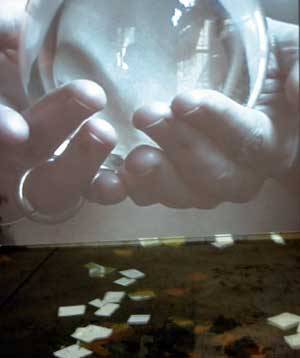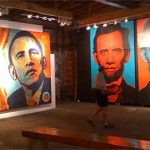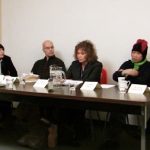Meet a NYFA Artist: Anita Glesta
NYFA speaks with 2002 Fellow in Architecture/Environmental Structures, and Fiscally Sponsored Artist in 2003, Anita Glesta.
NYFA: Hi Anita, Please tell us what are you working on and what’s coming up for you.
AG: I have had two two large-scale public projects that were realized last year and which took four years to complete. One project was the entire landscape for the Federal Census Bureau Building outside of Washington, D.C. (Suitland, Md). This was a General Services Administration Excellence in Art and Architecture commission. For this work I have created a giant walk of “numbers.” The work is comprised of oversized concrete numbers and areas of hand-painted tiles that playfully scattered throughout the seven-acre landscape of the new Skidmore, Owings, and Merrill complex. The tiles are the numeric systems from the different cultures of the world that represent the diversity of the population of the United States.
The other large project which I completed last year was a multi-channel video installation shown at White Box in Chelsea and then, one month later, at the LMCC at Chase Manhattan Plaza (as public artwork). Both works centered around interviews I conducted with survivors of the bombing of the village of Guernica, in Northern Spain in 1937. These two enormous projects led me into working with new media technologies such as video and sound and I have spent the year exploring these mediums, which I have found fascinating and expansive.
In early 2009, I had a residency in Bogliasco, Italy. During my month-long stay there, I did a work with video that references Masaccio’s Expulsion from the Garden. “The Expulsion, Birds and Gardens” will be shown at Five Myles gallery and opens on the 29th of March. I am excited to work in this medium. For the White Box exhibition I created a multi-channel installation. One element of the installation was a video river crossing the twenty-foot floor of the space. The river flowed and paper floated across what appeared to be a river of blood. I was intrigued with how the video could transform the architecture of the space. I have carried this concern from that work into the piece I created for Five Myles because this one is a multi-channel work that references a quattrocento fresco, its humanism and integration into the architecture of the churches. Working in a video format incorporates my lifetime of concerns as an artist. It is at once painting, sculpture and architecture. Creating this work is akin to composing music or choreography because it is about arranging elements in a scope that is not limited to one form. There is a symphony of images and rhythms. For this particular work I had the opportunity to work with the dancer/choreographer, Vanessa Justice, who was in residence with me in Bogliasco. For the part of Eve, Ms. Justice did a beautiful interpretation of Eve’s gesture. She captures the frozen movement from Masaccio’s fresco and slowly imbues her with life.
Other upcoming works this year will be my Gernika installation traveling this spring to La Paz, Bolivia as an installation and later in the fall will also travel to Argentina and Uruguay. The documentary alone will also be shown in a conference on Memory in Montreal in April. The conference is called “Memory in the aftermath of Conflict and Violence” and is in April at Concordia University center for memory and research, CEREV. I will be showing video installations at the Basel Art Fair and in Italy in 2010.
NYFA: How do you start on a project?
AG: I once heard a composer quoted on how artists conceive their ideas. He likened the process to cutting open the belly of a shark. If an artist’s brain were opened it would be like a shark’s belly: you might find a license plate alongside a refrigerator and a pineapple. The contents of the brain are various, and where and how the connections form into an artwork or creativity in general seems to make no sense in parts but somehow come together to work in the end.
Often my work will evolve seamlessly, growing from the materials and concepts I would like to further explore. However, working on public art commissions, there are restrictions imposed by the physicality of the site (since I work site specifically) as well as budgetary constraints. Sometimes there are political concerns as well working within community. I view these as challenges rather than limitations and I enjoy that. However to be honest, these challenges can also be frustrating and often, it can compromise the work. As an artist working in the public, you really have to be strong and I believe that artists should be educated much more in art schools about this kind of work to prepare them for this area of work which undervalued and rich in potential. I have been teaching a public art workshop at the School of Visual Arts for the last few years in their summer residency programs as well as teaching overseas in Australia and Europe. As a teacher, I always try to address the multi faceted aspects of doing this kind of work.
NYFA: If you could be transported anywhere, where would you choose to go?
AG: If I could be transported anywhere to live it would be the Mediterranean. I am a native New Yorker and I have lived in many parts of the world but I always feel happiest when I am in a Mediterranean country. The essence of human history contained in the old stones of the buildings is comforting to me, and the constant talk about food and politics and romance feels right.
NYFA: Is there anything that you’d like to see addressed more adequately by artists service and funding organizations? If so, how might this issue be addressed?
AG: It is so important that an organization like NYFA exists. In NYC, there are so many artists and to know that there is a support organization which is also a clearing house of information, workshops, jobs etc. is enormous. Not to mention, money!! With so many artists living in NYC and so little federal funding for the arts compared to other countries, I understand the enormous role and responsiblity that NYFA has to serve this group. Having lived and worked abroad over the last two decades, I know that compared to places like Europe and Australia, artists in NYC work in the most challenging conditions. That is why I appreciate what NYFA’s role. Since it is not a federal organization like the other countries’ councils, this makes their role an even large task. I am actually thinking that the idea of a Minister of Culture really makes sense.
Having lived and worked in Sydney, Australia for many years I was the recipient of some grants from the Australia Council for the Arts. Participating in Sydney’s art community made me more aware of the councils various roles. It was not a resource center the way NYFA is and like everything else, it had pluses and minuses as an organization. But, besides dispersing large amounts of money in fellowships (from the federal funding it recieves from the Australian Government) one of its other funcions was to provide a published standard for “Art Worker Fees.” There was actually an artist’s hourly wage standard for working freelance on projects. I think it’s interesting for artists who are not reliant on the gallery market but rather have to do other kinds of art related consultancy, such as public art and teaching among other "jobs” in the arts.
In New York, I think one of the other roles that an organizations such as NYFA might have is as an advocacy group for improved studio/housing for artists. Real estate is so impossible in New York that artists are forced to leave. With this bad economy it would be an interesting time for an arts organization to support an initative towards affordable and sustainable housing that would include the design and labor of artists and architects. My suggestions for the role of NYFA in addition to helping artists with grants and fiscal sponsorship is perhaps to be a think tank for new kinds of WPA-like initiatives.
NYFA: What role has the Fellowship played in your life?
AG: I have been a recipient of NYFA’s support in many ways. NYFA has been a very important source of support financially and emotionally. My well being as an artist, both physical and emotional, has been their concern. I appreciate being one of thousands of artists helped by NYFA. I was a fellow for the Environmental Structures in 2002; I also received support from NYFA after 9/11 in the form of an Artists Recovery Grant, as part of the downtown artists who were affected. For my Gernika Project I recieved fiscal sponsorship from NYFA which resulted in a NYSCA grant, without which I am quite sure I would not have been able to do this large scale project. In additon to the new media technologies grant, I was able to fundraise for more money, which would not have been possible as an individual artist. NYFA has been a source of support and encouragement in many ways for the last ten years since I have returned to NYC, my hometown.
For more information on Anita Glesta, visit her website.





